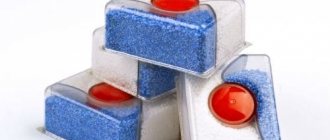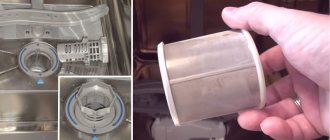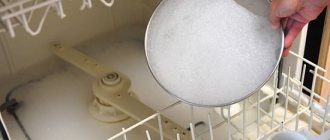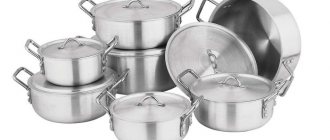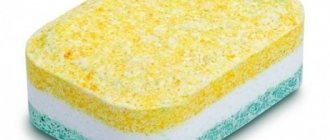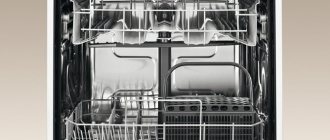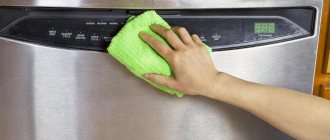The first mechanized dishwasher went on sale in 1886. American Josephine Cochrane said to herself “I am a woman, not a dishwasher!” (more precisely: “If nobody else is going to invent a dishwashing machine, I'll do it myself!”) and invented the dishwasher.
In the 1950s, compact dishwashers suitable for home use began to be sold. Since then, this household appliance has been a typical “resident” in American kitchens, along with a refrigerator or coffee maker.
In our country, dishwashers have long been considered an unaffordable luxury. But in recent years, more and more people are realizing their advantages (saving time, quality of washing).
From this article you will learn how to properly wash dishes in a dishwasher, as well as what to do to ensure that the appliance serves you for many years.
Dishwashers come in floor-standing (free-standing or built-in) and countertop (compact) types. Floor-standing dishwashers are also divided into “narrow” (45 cm wide, for 9-13 sets) and “full-size” (60 cm wide, for 7-16 sets).
A set is a set of dishes for one person (tureen, flat plate, saucer, mug, cutlery).
In addition, dishwashers differ in operating modes, type of load, efficiency of water and electricity consumption and other parameters.
But regardless of the brand of dishwasher, there are general rules for its operation. Let's get acquainted with the main ones.
Rule No. 1 – Place dishes inside the machine correctly
As a rule, modern dishwashers are equipped with 2 baskets for loading dishes. The lower one is intended for large items (pots, pans, large dishes). The top one is for tableware (plates, cups, etc.). Spoons, forks, knives and other cutlery are usually placed in a special tray that comes with the machine or is sold separately.
To optimally place dishes inside the machine, start loading from the lower basket. Place large plates on the edges, small ones closer to the center. There, in the middle, place a tray with cutlery (if there is none, still put the forks and spoons in the center).
The dishes should not interfere with the rotation of the machine's rocker arms. Therefore, do not place pans and other items with long handles vertically.
Water in the dishwasher is usually supplied from the bottom up, so place hollow items (mugs, plates, cups) upside down. Do not lay them on their sides - water and detergent will remain. In addition, it is not recommended to stack objects on top of each other.
Do not overload the machine. And if the dishes are very dirty, then it is better to place the plates not in each cell of the basket, but every other.
But the most important thing to remember is which dishes can be washed in the dishwasher and which cannot.
What should not be washed in the dishwasher:
- old cracked or glued dishes;
- wooden objects (cutting boards, knives with wooden handles, etc.);
- objects made of rusting steel, copper and tin;
- non-heat-resistant dishes (glass and plastic).
What is not recommended for washing in the dishwasher:
- silver and aluminum items (or only using special detergents and washing programs);
- crystal dishes (or only with special products and gentle washing modes);
- earthenware (if the detergent and washing program are selected incorrectly, the glaze and designs may fade).
At the end of the wash cycle, wait 10-15 minutes for the dishes to cool. If you take out the dishes right away, you can get burned. In addition, hot dishes break more easily.
Do not use the dishwasher as a washing machine. Do not wash kitchen towels, sponges or other utensils in it.
How to choose a dishwasher
There are three types of dishwashers on the market - freestanding, integrated and semi-integrated.
- Freestanding dishwashers are the most common type. They are full-fledged dishwashers that occupy a separate space.
- Integrated dishwashers are designed to be built into special kitchen cabinets. Their peculiarity is that the front panel is completely hidden behind the kitchen cabinet door. The downside is that it’s not so convenient to track work time.
- Semi-integrated dishwashers offer two options at once: they are built into the kitchen cabinet and display a front control panel.
Obvious advantages:
A dishwasher with a low noise level during operation, economically and, most importantly, performs the process of washing dishes very efficiently. The main goal of the PM development company is to minimize energy and water consumption.
For example, a modern equipped dishwasher spends about 10 liters in the process of washing dishes. water. It is quite difficult to approach such an indicator when working manually.
The following factors help ensure these indicators.
- Availability of ion exchange capacity. It is the provision of water supply through this chamber that makes the water softer, thereby increasing its cleaning ability.
- The purification filter system allows you to reuse a certain volume of water.
Economical water consumption is not the only advantage of PM. A carefully designed heat exchange scheme can significantly reduce power consumption when heating water.
Rule No. 2 – choose the right washing mode
A standard dishwasher cycle includes pre-wash (rinsing off food residues with cold water), wash (directly washing with hot water using detergent), rinse (rinsing off detergent) and drying.
In addition, in dishwashers there are such programs as intensive washing (very high tº - up to 75 degrees), a program for fragile dishes (water tº - from 30 to 40 degrees), quick wash (when you need to rinse the dishes after liquid food and immediately after meals) and others.
The program you choose (washing time and temperature) must correspond to the type of dishes and the degree of soiling.
In addition, dishwashers of the middle and highest price categories have a “pre-soak” function. But it is much easier and more economical to manually clean off dried-on food residues from them before loading the plates into the machine. The same thing with “burnt” pots and pans.
Additional functions of PMM
In parallel with dishwasher modes, they can also have additional functions. Almost all of them are equipped with leakage protection. If there are small children in the house, you need a unit with the ability to lock the control panel or door.
The ability to add forgotten dishes after starting the machine is also a very convenient feature. Elite models are equipped with loading sensors. In this mode, the PMM selects both the volume of water and the time spent on the cycle.
Some models have additional elements - sensors for monitoring water purity and hardness. A sensor for monitoring the degree of water purity forces the unit to rinse everything loaded into the machine until the liquid becomes perfectly clean. If the water is very hard, the machine will determine how much softening salt to add.
The panel for launching additional functions for built-in PMM models is located at the end of the door
Built-in units in working condition project a red beam onto the floor plane. When the process is completed, it disappears or its color changes to green. This is very convenient, because... makes it possible to monitor the operation of the built-in dishwasher.
Control of washing modes
All modes in the PMM are coordinated in two ways: electromechanical and electronic. The second method is more comfortable, and all modern models are equipped with it. The first provides for the presence of buttons, switches and keys on the body, and they are controlled manually.
Control of some PMM models is simplified due to the presence of clear symbols in the designation of standard programs. These are glasses, pots and other items (+)
With electronic control, both the washing mode and other programs are set using commands. If the PMM board fails, only a specialist can repair it. Experience shows that most often the programmer will have to be changed.
The final stage of machine operation
At the end of the cycle, the contaminated liquid goes down the drain. This is followed by a drying stage. It can end in 30 minutes or last more than an hour.
A special signal sent by the device will notify you of the end of the program. The sound volume is adjusted using convenient indicators placed by the manufacturer on the control panel. With their help, you can completely disable the alert function if you plan to load the machine overnight.
When the unit stops completely, press the on/off button. Then the door is opened slightly to allow the dishes to cool faster.
After drying, a high temperature remains inside the unit, so it is not recommended to immediately empty it of its contents. In addition, cookware made from certain materials becomes very fragile when hot.
After the beep sounds indicating the end of the wash, you should wait a while before removing the dishes.
It happens that the cycle is completed, but the dishwasher does not turn off. The most likely cause is an electronic problem. This may also be a consequence of blockage of the drain hole with food debris. The machine cannot shut down correctly.
Rule #3 – Use the right detergents
Dishwashers use special detergents.
Do not use regular dishwashing gels and powders.
Dishwasher detergents can be divided into two types - powder and tablets.
Powders are more common. On average, its consumption per 1 dishwasher cycle is 25-30 grams.
Tablets are considered more convenient. They are single-layer, multi-layer and combined. The latter are considered the most practical, as they combine detergent components, rinse aid and regenerating salt. If your car model allows for the use of such products, you will not have to buy three different substances.
The consumption of tablets is approximately 1 tablet per 1 cycle.
It is not recommended to use tablet detergents in gentle washing programs - the tablet does not have time to dissolve.
Based on their properties, dishwashing detergents can be divided into strongly alkaline and weakly alkaline (usually with enzymes). Enzymes are biological enzyme additives that break down proteins, fats and polysaccharides that make up contaminants. Enzyme products are usually used to wash fragile dishes.
Bigger doesn't mean cleaner. Use as much detergent as directed in the instructions.
In addition, unless there are special instructions on the packaging, you should not wash fragile or silverware with it.
In addition to detergent, to use your dishwasher effectively, you need rinse aid. It removes detergent residue, adds shine to dishes and helps them dry quickly. Rinse aid consumption is approximately 0.5-0.7 liters for 10-12 cycles.
Cooking food
Recently, especially in European countries, the concept of “dishwasher cooking” has become popular. Using this technique, you can easily cook fish in foil, apple pie, and pickled vegetables. It seems unusual, but in fact everything is simple, fast and safe. Let's look at an example of preparing one of the dishes below.
Potatoes with herbs in olive marinade.
Cut the potatoes into small slices. It is better to chop it finely so that it cooks faster. Sprinkle with Provençal or Italian herbs, olive oil and salt. All this must be wrapped in a sleeve or foil in several layers. You can also load dirty dishes next door. We select the mode for dishes with a medium degree of soiling.
Rule No. 4 – watch the water hardness
The cleanliness of dishes washed in the dishwasher also depends on the hardness of the water. Hard water leaves white streaks on dishes.
In most cases, water softening is required for the machine to function properly. For this, regenerating salt is used. Usually the capacity for it in cars is quite large - 1-2 kg. It lasts long enough.
In addition, lime from hard water settles on the heating elements of the machine, which can cause damage. Therefore, salt is also necessary to protect the device.
Rule #5 – Take care of your dishwasher
Any technique loves care. Dishwashers are no exception. If you want your machine to serve you for a long time, follow these recommendations.
Clean the filter from time to time (washed-out food residues settle on it). Also wash the dish baskets regularly (they are usually easy to remove).
Use additional dishwasher care products. So, every 15-20 cycles it is recommended to use a degreaser (powder or gel product). It helps remove accumulated grease from the inside of the machine.
Also, give your car “prevention” 2-4 times a year. To do this, you can use a special product or regular citric acid. Pour anti-scale into the dispenser and turn on the unloaded machine on a standard cycle.
Finally, at least once a week, wipe the dishwasher with a damp cloth, inside and out, not forgetting the door seal.
